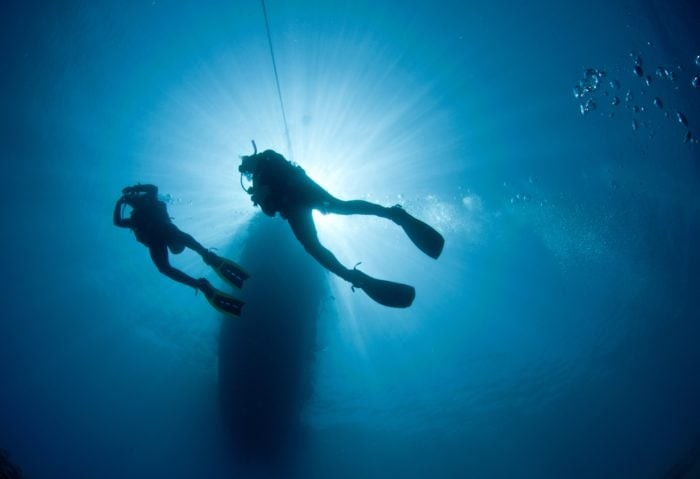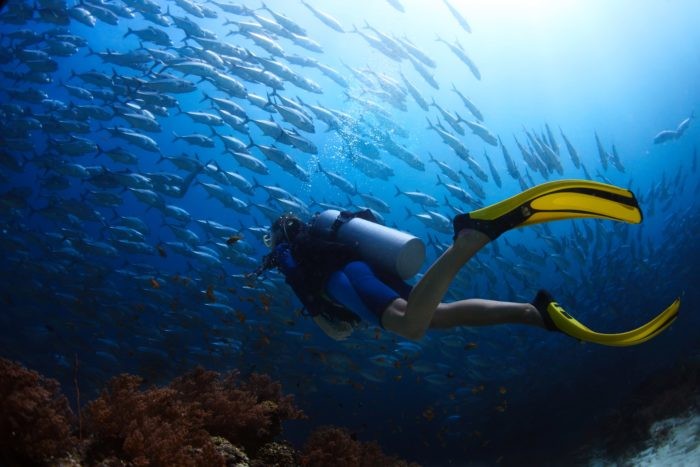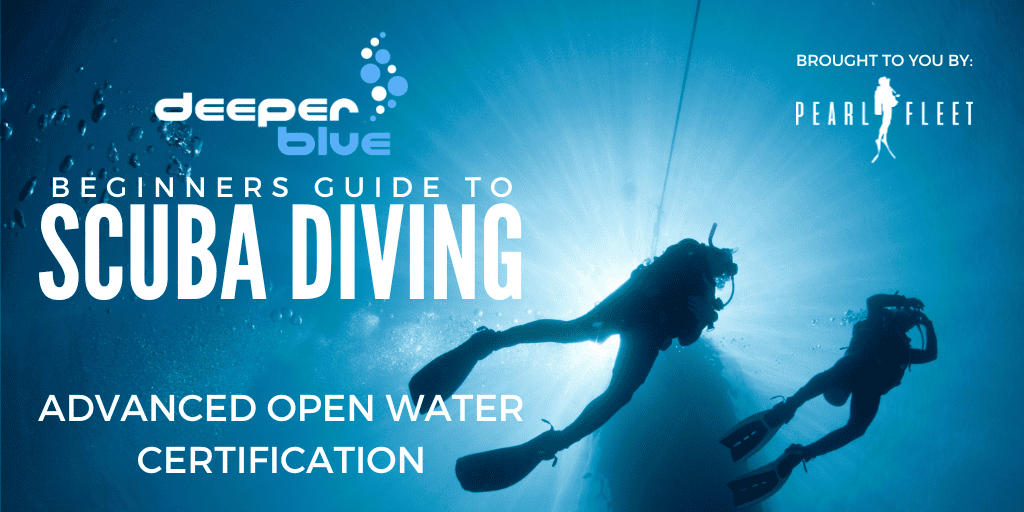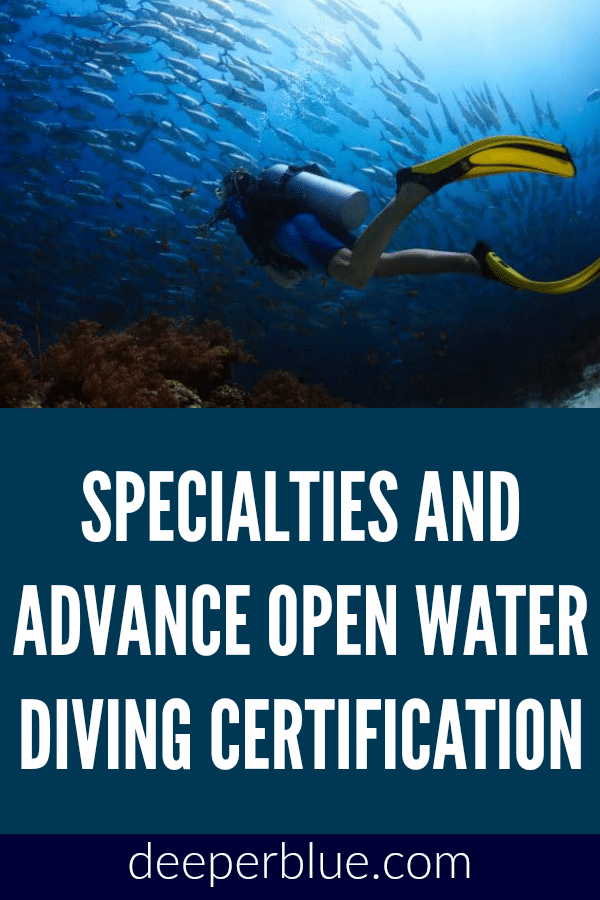This article is part of the Beginners Guide to Scuba Diving
After you have your Open Water Diver certification complete, you will often have divers tell you what training you should take next. The amount of advice you get may be overwhelming. The first suggestion will be to take the Advanced Open Water Diver (PADI) training or Advance Adventure Diver Training (SSI).
This advice is well-meaning and for many divers a good plan for additional training. As an OWD, you are certified to dive to the depth 60ft/18m. As long as you are comfortable staying within that depth limitation, there is no requirement for additional training.
While there are dozens of specialty programs, hundreds if you include PADI’s distinctive specialty courses, only a few are mandatory before recreational divers can dive in that area. Here are the mandatory programs and why they are:
- Advanced Open Water Diver (AOWD): The primary outcome of this training program is that it changes the maximum depth that a diver can dive. Advanced Open Water Divers are able to dive to 100 feet 30 meters. Advance Adventure Diver Training (SSI) is equivalent is PADI’s AOWD. SSI has additional requirements for their AOWD.
- Deep Diver Specialty: The AOWD certification allows diving to 100 feet 30 meters. Deep diver training adds another 30 feet/ 10 meters allowing the diver to dive to a recreational limit of 130 feet/ 40 meters.
- Enrich Air Nitrox Diver (EAN) Specialty: Dives must be certified to dive with enriched air. There are additional steps that must be done when diving with EAN and additional risks to address.
- Overhead Environments Specialties: Diving in an overhead environment, one that does not have a direct ascent to the surface, requires a special certification. Wreck penetration is the most common overhead environment, however, it also included cavern and ice diving. These certifications train for the additional risk these environments address
- TEC: The Technical programs are beyond the scope of the recreational diver. They can include deeper depths than the recreational diver can accomplish, the use of different breathing gasses, and decompression diving. Additional training is required to become a technical diver.
Many divers will take the first three of these programs and not feel the need to take any other training. If you are interested in any of the other specialties, they are nice to have but not required for you to try them yourself. Provided you stay within the depth limits of your certification.
Specialty programs
The specialty programs are geared towards teaching a diver the skills they need to enjoy a certain type of dive. Other than the ones listed above as mandatory, you are not required to take a specialty to do a dive in those conditions. They are designed to help you learn what may interest you.
Each of the dive accreditation agencies has about a dozen courses that you can explore. Many divers find marine life orientated specialties very helpful in understanding the marine life around them. Night diving is another one that many divers will choose because it allows them to understand more about the night experience.
PADI also has a program called Distinctive Specialties. These programs are designed by dive instructors and are less widely available. Some of these are designed to be done at only one location.

What is an Advanced Open Water Diver
Many experienced divers do not like the name of PADI’s Advanced Open Water Diver program. They feel that the word advance gives a false sense of competency to the new diver. Student divers are able to combine the Open Water Diver program and the Advanced Open Water Diver program into one course and be verified as an AOWD with only 9 open water dives.
PADI points out that they mean it as advanced training, not that the diver has advanced skills. Scuba Schools International takes a different view. Their Advance Adventure Diver Training is the same as PADI’s AWOD. SSI does have an Advanced Open Water Diver, however, it requires at least 24 dives and completion of the Advanced Adventure Diver Training.
PADI’s AOWD diver program is based on completing the first dive of five different specialties. Two of the specialties that are mandatory are deep diver and navigation. The other three are selected by the diver so the course best fits their needs. The training method used in the advanced course is the same as in the open water class as they use the knowledge portion, the confined water session, and open water sessions.
Adventure dives
The term adventure dive is a fairly recent concept to dive training. The first dive of a specialty program has always been an element of the Advance courses. However, they were not available separately. Now they are available to certified divers as an adventure dive. The diver experiences the same lesson as the first dive including knowledge and confined water if included, as a student taking a specialty.
Divers who take three adventure dives can receive an adventure diver certification. This works similar to the way Scuba diver is about half of the Open Water Diver. While each specialty has its own knowledge manual, the adventure diver knowledge material is grouped together so only one knowledge package is needed.

Rescue Diver
The Rescue Diver certification for PADI and SSI’s Diver Stress & Rescue certification is a different type of specialty course and the most demanding of all the recreational diving programs. While the other programs have been designed to help you improve your diving, this one expands to helping other divers.
A first aid certification is a prerequisite to start this training. It takes your previously learned in-water skills and your first aid training and applies it in simulated emergency situations. It requires rescuing “victims” and starting the first responder treatments. You will learn different methods to handle a variety of situations.
The program also includes skills such as accident management. This course is the prerequisite to enter the professional training programs to become a divemaster/ dive leader and on to the instructor.
Master Diver or Dive Master
In recreational scuba diving, the terms Master diver and divemaster mean two entirely different things. The divemaster is the first professional rating in recreational scuba divers and is the path from rescue diver to instructor ratings. Master Diver is the highest rating outside the professional progression. Only 5% of scuba divers will ever earn the certification. The requirements for the Master diver are the completion of rescue diver certification and holding certification in five additional specialties.
As an open water diver, it is entirely up to you which path you will follow and even where on the path you wish to stop. Taking the Advanced Open Water course is a very good option that most divers do and benefit from the extra training and additional depths. What do you find interesting in the sea?
Click here for more articles in the Beginners Guide to Scuba Diving
Brought To You By
Our Beginners Guide to Scuba Diving is brought to you by Pearl Fleet. Pearl Fleet invites you to embark on their exquisitely crafted yachts for the finest diving experience the world has to offer. From purposefully designed diving itineraries to high-class amenities, Pearl Fleet’s immersive getaways allow you to indulge in your passion as you journey to world-class diving destinations. You can find out more at pearlfleet.org.



